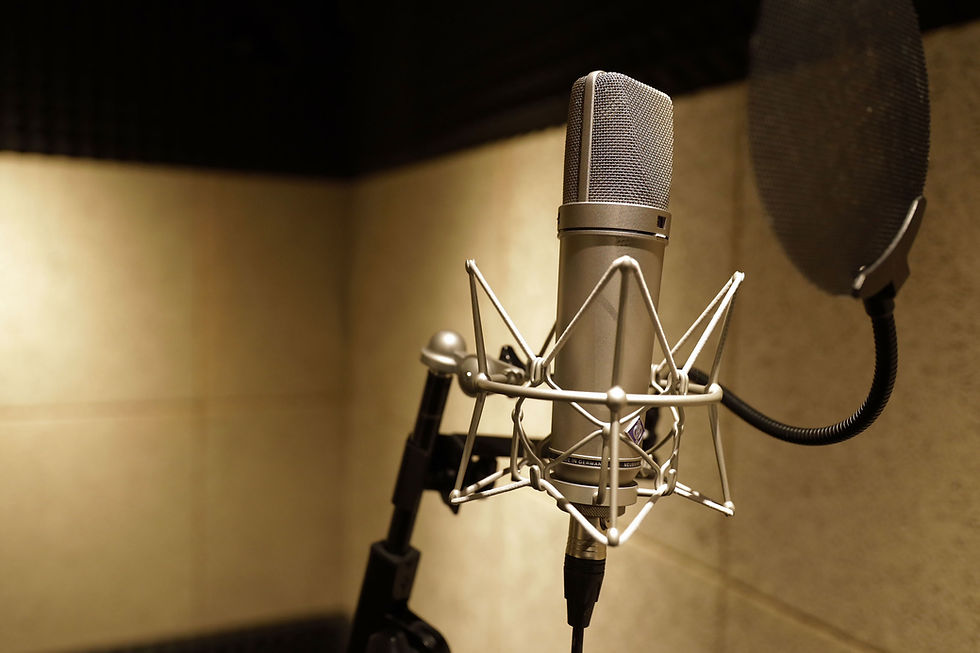Mic Technique: Making Every Word Count
- Voodoo Sound
- Feb 19, 2024
- 3 min read

A mate of mine, and Pro Audio Suite Co-Host George 'The Tech' Witham recently shared a great diagram on mic techniques that sparked a bit of a brainstorm for me on the sublect. So I thought I'd expand on his genius and give you some real-deal strategies to nail your next recording.

1. Harnessing the Proximity Effect: That intimate or authoritative vibe comes from getting up close and personal with your cardioid mic. But it's easy to overdo it. Cozy up to your cardioid and feel the bass bloom. Great for when your voice needs to wrap around the listener like a warm blanket. But remember, like a heavy bass line in a delicate ballad, there's a time and place.
Tip to try: Record a paragraph at different distances, starting close, and slowly moving back from your initial position. Listen for when the bass boost complements your voice without muddying it. That's your sweet spot.

2. The Art of Distance: Too much bass can drown the subtleties in your voice. Distance can be your ally for clarity and honesty in your sound, especially for narrative and conversational pieces. Perfect for when you want to sound like you're part of the everyday convo, not narrating it from on high.
Tip to try: Move back in small steps and record the same sentence. Notice the point where your voice sounds natural and conversational, not thin or distant.
3. Tackling Plosives: Plosives aren’t just about 'p's and 'b's – 't's can also cause trouble. They're like audio speed bumps; they need to be smoothed out. Keep that mic angled and avoid blowing your listeners away with unintended audio artillery. It's about finesse, not force.
Tip: If you struggle with plosives, the pencil trick still stands. Hold it in front of your lips when pronouncing plosive-heavy words. It disperses the air and keeps it out of the diaphragm and your takes pop-free.
4. Sibilance – Steering Clear of the Hiss: A hissy 's' can pull focus from your message. It’s all

about mic position and technique to soften those sibilant sounds. Find that sweet spot where your 's' and 'sh' sounds shimmer, not shout.
Tip: Just like popping, angle yourself slightly off the mic and speak across the capsule, not directly into it. This simple change can make a world of difference.
5. Ear Training with Practical Exercises: Your ears are your best tool. Knowing how your voice sounds at different mic positions and distances is crucial.
Tip: Record a script in various ways. Listen back critically. Make notes on what works and why. This is how you’ll develop your signature sound.

6. Mastering the Figure 8 Pattern: If your mic supports it, the figure 8 is a specialist's choice, perfect for when you're aiming to capture your voice with precision while ignoring side chatter. This bidirectional pattern captures audio from the front and back of the capsule, while rejecting the sides, allowing you to capture the nuance of your performance while the mic gives the cold shoulder to unwanted noise. It's about using rejection to your advantage. You can also play with the position of your mic in the room to use this trick to its greatest effect.
Tip: Position the mic so that the unwanted noise sources are directly to the sides. This pattern rejects noise from these areas, letting you focus on the performance.
All these techniques are about making sure your voice is heard just the way you intend. But if you're ready to take it to the next level and want a killer demo, Voodoo Sound is where it's at. We've got the gear, the ears, and the know-how to make sure your demo isn’t just good, it’s you, at your best – every time.
Until next time, keep speaking and recording with intention.







Comments